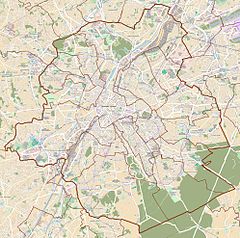Brussels Town Hall
| Brussels' Town Hall | |
|---|---|
 Town Hall of the City of Brussels | |
| General information | |
| Architectural style | Gothic |
| Location | Grand Place |
| Town or city | City of Brussels, Brussels-Capital Region |
| Country | Belgium |
| Construction started | 1402 |
| Completed | 1420 |
| Height | 96 metres (315 ft) |
| Design and construction | |
| Architect(s) | Jacob van Thienen, Jan van Ruysbroek |
| Engineer | Guillaume de Voghel |
The Town Hall (French: Hôtel de Ville, Dutch: ) of the City of Brussels is a Gothic building from the Middle Ages. It is located on the famous Grand Place in Brussels, Belgium, opposite the Brussels City Museum. It is the only remaining medieval building of the Grand Place and is considered a masterpiece of civil Gothic architecture and more particularly of Brabantine Gothic.
History
Gothic Town Hall
The oldest part of the present Town Hall is its east wing (to the left when facing the front). This wing, together with a shorter belfry, was built and completed in 1420 under direction of Jacob van Thienen. Initially, future expansion of the building was not foreseen, however, the admission of the craft guilds into the traditionally patrician city government apparently spurred interest in providing more room for the building. As a result, a second, somewhat longer wing was built on to the existing structure, with Charles the Bold laying its first stone in 1444. This west wing was built by Guillaume (Willem) de Voghel who, in 1452, also built the Magna Aula at the Palace of Coudenberg. The facade is decorated with numerous statues representing nobles, saints, and allegorical figures. The present sculptures are reproductions; the older ones are in the city museum in the King's House across the Grand Place.
The 96-metre-high (315 ft) tower in Brabantine Gothic style emerged from the plans of Jan van Ruysbroek, the court architect of Philip the Good. By 1454, this tower, replacing the older belfry, was complete. Above the roof of the Town Hall, the square tower body narrows to a lavishly pinnacled octagonal openwork. Atop the spire, stands a 5-metre-high gilt metal statue of the archangel Michael, patron saint of Brussels, slaying a dragon or devil. The tower, its front archway and the main building's facade are conspicuously off-centre relative to one another. According to a legend, the architect, upon discovering this "error", leapt to his death from the tower. More likely, the asymmetry of the Town Hall was an accepted consequence of the scattered construction history and space constraints.
Classical wings
After the bombardment of Brussels in 1695, by a French army, under the Duke of Villeroi, the resulting fire completely gutted the Town Hall, destroying the archives and the art collections. The interior was soon rebuilt, and the addition of two rear wings, in the classical style (Louis XIV style), transformed the L-shaped building into its present configuration: a quadrilateral with an inner courtyard, completed by Corneille Van Nerven in 1712.
-
North-west facade of the inner courtyard -
South facade of the courtyard -
The Scheldt by Pierre-Denis Plumier
19th century restorations

The Town Hall underwent many restoration campaigns throughout the 19th century, first under the direction of Tilman-François Suys, starting in 1840. The Gothic interior was later revised by Victor Jamar in 1868, in the style of his mentor Viollet-le-Duc. It was at this time that most of the statues of the Town Hall were made. The interior halls were replenished with tapestries, paintings, and sculptures, largely representing subjects of importance in local and regional history.
-
The tympanum of the portal -
Statues of Dukes and Duchesses of Brabant -
The windows of the second floor of the right wing -
Knight of the Noble Houses of Brussels
Contemporary history
The Town Hall accommodated not only the municipal authorities of the city, but also the States of Brabant until 1795. In 1830, a provisional government assembled there during the Belgian Revolution, which provoked the separation of the Southern Netherlands from the Northern Netherlands, resulting in the formation of Belgium as it is known presently.
At the start of World War I, as refugees flooded Brussels, the Town Hall served as a makeshift hospital.[1] On 20 August 1914, the occupying German army arrived at the Grand Place and hoisted a German flag at the left side of the Town Hall.[1]
The Town Hall has been designated a historic monument since 9 March 1936.[2] It is a UNESCO World Heritage Site since 1998 as part of the registration of the Grand Place.[3]
Gallery
-
Brussels' Town Hall during the day -
Brussels' Town Hall in the evening
References
- ^ a b "Occupation of Brussels on 20 August 1914". City of Brussels. City of Brussels. Archived from the original on 17 September 2016. Retrieved 3 September 2016.
- ^ "Bruxelles Pentagone - Hôtel de ville - Grand-Place 8". www.irismonument.be. Retrieved 2019-05-12.
- ^ Centre, UNESCO World Heritage. "La Grand-Place, Brussels". whc.unesco.org. Retrieved 2017-11-01.
External links
- Brussels Town Hall - trabel.com
- Town hall and belfry, Brussels - Belgiumview
- Guided tours in the City Hall of Brussels - brussels.be










